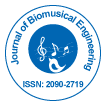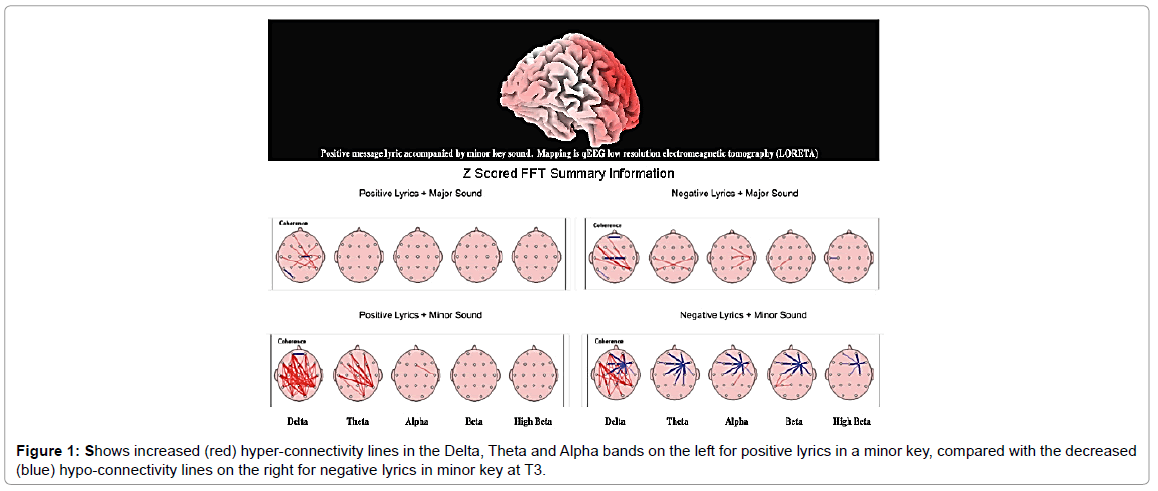Letter to Editor Open Access
Brain Responses to Positive and Negative Messages in Song Lyrics
Eric B Miller* and Rieko Eguchi
Montclair State University, David Ott Lab for Music and Health, USA
- *Corresponding Author:
- Eric B Miller
Montclair State University,
David Ott Lab for Music and Health, USA
Tel: 973-655-3060
E-mail: Millerer@mail.montclair.edu
Received date: February 07, 2016; Accepted date: March 22, 2016; Published date: March 24, 2016
Citation: Miller EB, Eguchi R (2016) Brain Responses to Positive and Negative Messages in Song Lyrics. J Biomusic Eng 3:114. doi:10.4172/2090-2719.1000114
Copyright: © 2016 Miller EB, et al. This is an open-access article distributed under the terms of the Creative Commons Attribution License, which permits unrestricted use, distribution, and reproduction in any medium, provided the original author and source are credited.
Visit for more related articles at Journal of Biomusical Engineering
Abstract
This single-subject pilot study investigated how the brain would react while listening to different combinations of major/minor sound and happy/sad lyrics. EEG was recorded across various combinations of musical mode and song lyric messages. Theta/Beta ratio did not decrease significantly at any site while listening to a positive message in minor key, the subject’s reported favorite condition. During negative lyrics in minor key, however, Theta/Beta decreased at T3 (p=0.048), at Pz (p=0.039), at Cz (p=0.050), at P3 (p=0.033), and at C3 (p=0.028). Hyper-connectivity was seen for the Delta, Theta and Alpha bands during positive lyrics in a minor key, compared with the hypo-connectivity for negative lyrics in a minor key at T3 seen for Delta, Theta, Alpha, Beta and High Beta.
Letter to Editor
We tend to associate major keys with happy emotions, and minor keys with sad emotions. In a Canadian study of 16 participants [1], major/ minor mode contributed to happy/sad judgments, as did tempo. We are also influenced by the spoken word. Positive words catch attention and influence incoming processes [2]. An fMRI study suggested that happy music without lyrics and sad music with lyrics induce emotions more deeply than happy music with lyrics and sad music without lyrics [3]. Various dynamics and relationships exist between music and words. How might the brain react if a song had positive lyrics in a minor key? Or suppose the brain hears negative lyrics in major key?
This single-subject pilot study investigated how the brain would react while listening to different combinations of major/minor sound and happy/sad lyrics. Slow wave activity is typically associated with a relaxed brain state while fast wave activity is indicative of arousal [4]. We measured brain waves with a topographical 19 channel EEG. A subject listened to 4 conditions of music: positive lyrics in major key (PM), negative lyrics in major key (NM), positive lyrics in minor key (Pm) and negative lyrics in minor key (Nm) (Figure 1).
Figure 1: Shows increased (red) hyper-connectivity lines in the Delta, Theta and Alpha bands on the left for positive lyrics in a minor key, compared with the decreased (blue) hypo-connectivity lines on the right for negative lyrics in minor key at T3.
The cortical location T3 “lit up” for this subject showing a high level of responsiveness. T3 is associated with Brodmann areas 21 and 22 which include the section called Wernicke’s area that is responsible for interpretation of meaning in speech.
Theta/Beta ratio may be utilized to gauge cortical relaxation/ arousal in some contexts [4]. With Beta increasing in the denominator, the corresponding lower ratio suggests elevated arousal.
Theta/Beta ratio did not decrease significantly at any site while listening to a positive message in minor key, the subject’s reported favorite condition. All other conditions however, displayed significant decreases in Theta/Beta ratio, suggesting that the subject was most relaxed during the positive message in the minor key. During positive lyrics in major key, Theta/Beta ratio decreased at C3 (p=0.032), at T3 (p=0.003), and at T4 (p=0.022). During negative message lyrics in a major key, Theta/Beta decreased at T3 (p=0.008), at Pz (p=0.047), at P3 (p=0.030), and at C3 (p=0.014). During negative lyrics in minor key, Theta/Beta decreased at T3 (p=0.048), at Pz (p=0.039), at Cz (p=0.050), at P3 (p=0.033), and at C3 (p=0.028) with several other sites approaching significance.
The most striking result was observed on the connectivity maps. Hyper-connectivity is shown for the Delta, Theta and Alpha bands during positive lyrics in a minor key, compared with the hypoconnectivity for negative lyrics in a minor key at T3 seen for Delta, Theta, Alpha, Beta and High Beta. This result corroborates those of a prior study finding that minor chords activated several brain areas, including the amygdala and cerebellum, more than major chords [5].
In this pilot study, minor keys appeared to indicate more relaxation effects than major keys overall, as major keys were associated with a higher level of arousal. When the minor key remained constant however, positive message lyrics displayed hyper-connectivity patterns while negative lyrics displayed hypo-connectivity patterns.
This pilot raises interesting questions for music therapists interested in neurologic response: Can a perceived positive/ negative message valence precipitate cortical slowing of brain connectivity patterns? Are there patients on either end of the spectrum where the slowing or acceleration would be a clinically desired effect? Might cortical hypo-activity relate to a meditative state, or conversely a “blocking” or avoidance effect? Further studies incorporating qualitative subject interview data combined with EEG measures across diverse emotional states and harmonic modes would help move our understanding of this phenomenon forward.
References
- Gagnon L, Peretz I (2003) Mode and tempo relative contributions to “happy-sad” judgements in Equitone melodies. Cognition and Emotion 17: 25-40.
- Sutton TM (2010) The influence of emotion on attention: examining the processing of negative and positive emotion words in the dot prove task. (Doctoral Dissertation) ProQuest UMI: 3403000.
- Brattico E, Alluri V, Bogert B, Jacobsen T, Vartiainen N, et al. (2011) A functional MRI study of happy and sad emotions in music with and without lyrics. Frontiers in Psychology 2: 1-16.
- Miller E (2011) Bio-Guided Music Therapy, London, Jessica Kingsley Publishers, UK.
- Pallesen KJ, Brattico E, Bailey C, Korvenoja A, Koivi sto J, et al. (2005) Emotional processing of major, minor, and dissonant chords: a functional magnetic resonance imaging study. New York Academy of Sciences 1060: 450-453.
Relevant Topics
Recommended Journals
Article Tools
Article Usage
- Total views: 12617
- [From(publication date):
June-2016 - Apr 02, 2025] - Breakdown by view type
- HTML page views : 11678
- PDF downloads : 939

